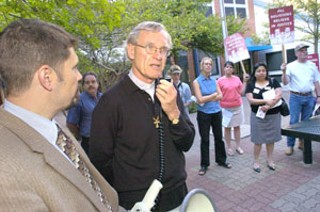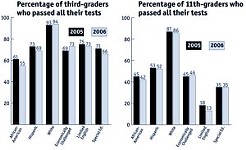The Prevailing Wage Guessing Game
Trustees worry that doing the right thing might cause bond dollars to come up short
By Rachel Proctor May, Fri., April 15, 2005

Sometimes it's not fun to be an elected public official. For the Austin ISD Board of Trustees, now is one of those times. After a grueling three-hour session on Thursday, April 7, the board postponed for two weeks a decision – already delayed a month – on whether to adopt a prevailing wage scale that includes money for benefits for workers on AISD construction projects. That question is not as much of a no-brainer as it appears: The board's decision could affect whether there's enough money to complete the eight new schools and hundreds of renovation projects included in the $519.5 million bond voters approved in August.
"Irrespective of the budget implications, we have to figure out the right thing to do," trustee Mark Williams said.
The dispute dates back to August, when the district was trying to drum up support for its $519.5 million bond package. At the time, labor representatives pointed out that the district's prevailing wage scale, which sets a minimum wage for workers on AISD construction projects, hadn't been updated since 1988. They, along with some Democratic groups, predicated their support for the bond on AISD's setting a new scale.
At the time, the labor groups wanted AISD to simply adopt the federal wage scale currently in use by all the other government entities in town. As a compromise, the district agreed to form a committee of labor and district representatives to come up with a prevailing wage scale of their own. The committee spent the past six months (and $125,000 in consulting fees) surveying the average wages and benefits earned by Central Texas ironworkers, carpenters, electricians, and other laborers, and developed a wage scale that reflects market average wages and benefits. When AISD officials presented the scale to the board, however, they recommended adopting only the wages, not the benefits. And to make matters worse (in the eyes of the labor representatives), no one told the committee members about the switcheroo beforehand.
"The way the district handled the recommendation, and dealt with the committee, will make it harder to get to where we want to be," said Greg Hartman, who last fall promoted the bond and helped negotiate the establishment of the prevailing wage committee.
The question isn't quite as simple as whether AISD should "pay benefits" to construction workers or not. Workers on AISD construction projects are not district employees; they are employees of the contractors who win bids on district projects. Those contractors are the ones who make benefit decisions; according to the survey, 52% of local contractors provide benefits, and 48% don't. So in essence, a wage scale that "includes benefits" is simply a slightly higher wage scale – it subsidizes the benefit packages of contractors that already have them, but does not require benefits from those that don't.
"We're not telling people to provide benefits," trustee Patricia Whiteside said. "So I don't know if we're affecting what's going on in the community regarding insurance."
A higher prevailing wage scale, however, will make it easier for contractors who offer benefit packages to compete with those who don't. For example, the proposed rate for iron workers is $16.97 in wages and $3.40 in benefits, for a total prevailing wage/benefit rate of $20.37. If AISD adopts this rate, contractors currently paying $17 an hour don't have to pay the $3.40 "benefits" in the form of benefits; they can simply pay it as extra wages. But the fact that they have to pay $20.37 an hour – whether that's in the form of wages or a wage/benefit package – means they can't quite so easily underbid those contractors who do offer benefits, and whose labor costs are thus in the $21 or $22 range. In other words, the district can raise the floor to give better-paying, benefit-providing contractors a fighting chance of winning some of the $321 million in construction projects included in the bond.
"There's no guarantee that anyone will pay benefits, but it's an allowance – a consideration – for those that do," trustee Rudy Montoya said. "It zeroes that factor out of the equation" as AISD is deciding between competing bids.
Whatever their instincts, trustees must simultaneously consider some harsh budget realities. Adding benefits to the wage scale will consume about $20 million of the district's $50 million contingency fund at a time when rising material and energy costs make cost increases virtually assured. (Labor disputes the $20 million figure; they say the higher wages and benefits won't make a dent in the contingency.) "The cost of steel and oil, that's what's going to make or break this bond package," says Hartman. "Labor isn't the single biggest issue."
This is no phantom menace – Austin Community College had to ditch plans for its cool, avant-garde South Austin campus when designs came in $5 million over budget, largely because of material cost increases between the time the project was envisioned and when it was put out to bid. The college will build a smaller, simpler (uglier) building in its place, and AISD worries the same thing could happen to them. There's also politics to consider: While a ruckus over labor will roil public sensitivities today, running out of bond money with schools half-built will roil them as much (or more) a few years down the road – about the time that AISD is looking to voters to pass the next bond issue. Superintendent Pat Forgione said convincing voters to approve another bond will involve showing them the district finished everything in this package "on time, within budget, and with quality" – something high labor costs could imperil.
However, trustee John Fitzpatrick countered that that isn't the only thing voters will consider when contemplating the next bond. "We are going to have to answer on two issues," he said. "Were we on time and under budget, and did we fulfill our commitments? I told people in the campaign that we would pay fair wages and benefits."
When political consultant Alfred Stanley, who helped promote the bond package, looks back on last fall's negotiations that resulted in AISD's putting together the prevailing wage committee, that's how he remembers it: that the committee would determine both wages and benefits.
"Saying that a wage study is wages minus benefits is disingenuous and in bad faith," Stanley said. "If Dr. Forgione made a mental note to himself that he never meant to include benefits when he said wages, he never bothered to express his mental reservation to anyone else in the world."
In the end, the board essentially has to make a bet. A higher wage/benefit scale might generate more benefits for more workers (or it might not); however, it might cause some projects to run out of money (then again, it might not). What it will definitely do is make a statement: that AISD cares enough about awarding bids to benefit-paying contractors to level the playing field so they can compete, and that AISD places a priority on spending public dollars on good employers. That's a statement several trustees said they desperately want to make; but given the uncertainty surrounding nonlabor construction costs, it still may not be a risk they're willing to take.
Got something to say on the subject? Send a letter to the editor.








